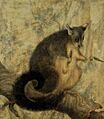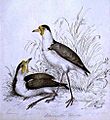Louisa Atkinson facts for kids
Quick facts for kids
Louisa Atkinson
|
|
|---|---|
 |
|
| Born |
Caroline Louisa Waring Atkinson
25 February 1834 Oldbury, near Sutton Forest, New South Wales, Australia
|
| Died | 28 April 1872 (aged 38) Swanton, near Sutton Forest, New South Wales, Australia
|
| Other names | Caroline Calvert, L.A., L.C. |
| Occupation | Botanist, journalist, novelist, illustrator |
| Spouse(s) | James Snowden Calvert |
| Children | 1 |
Caroline Louisa Waring Calvert (born Atkinson; 25 February 1834 – 28 April 1872) was an important early Australian writer, botanist, and artist. She was famous for her stories during her lifetime. Today, she is remembered most for her amazing work with plants.
Louisa was a pioneer for Australian women in writing and science. She was also known for her kind words about Aboriginal Australians in her books. She encouraged people to protect nature, which was very unusual for her time.
Contents
Louisa's Life Story
Louisa, as everyone called her, was born on her family's farm named "Oldbury." This farm was near Sutton Forest in New South Wales. She was the fourth child in her family.
Her father, James Atkinson, wrote an early book about farming in Australia. He died when Louisa was only eight weeks old. Louisa was a bit sickly as a child and had a heart problem. Because of this, her mother, Charlotte Barton, taught her at home. Charlotte also wrote Australia's first children's book!
Louisa's mother later married George Barton, a family friend. Sadly, he became very ill, and the family had to leave "Oldbury."
Louisa lived most of her life in Kurrajong Heights. Her mother built a home there called Fernhurst. Before that, she lived for a short time in Shoalhaven and Sydney.
Louisa was a very active member of her community. She helped people who couldn't read or write. She was also a trusted friend to children and cared for the elderly and sick. She even started and taught the first Sunday School in her area.
Louisa and her mother returned to "Oldbury" in 1865. Her mother passed away there in 1868. On 11 March 1869, Louisa married James Snowden Calvert. He was an explorer who had been on a famous trip with Ludwig Leichhardt. James was also very interested in plants, just like Louisa.
Louisa died at Swanton, near "Oldbury," in 1872. This was just 18 days after her daughter, Louise Snowden Annie, was born. She was buried in her family's tomb at All Saints' Church in Sutton Forest. The Sydney Morning Herald newspaper wrote that she was a wonderful lady. They said she was known for her writing, art, and her kind heart.
Louisa was also a bit of a trendsetter in how she dressed! She found the long skirts of her time very annoying when exploring the bush. So, she wore trousers when walking or riding her pony. This caused some gossip among the ladies of the colony!
Discovering Plants and Art
Louisa is known as a leading botanist. She found new plant species in the Blue Mountains and Southern Highlands of New South Wales. She also strongly supported protecting nature when many forests were being cleared. Her interest in plants came partly from her mother, who also loved art and nature.
She went on plant-finding trips far from her home, like to the Illawarra region. But she knew the plants around Kurrajong best. This included places like the Grose Valley, Mt Tomah, and Springwood.
Louisa collected many plant samples for famous botanists like Rev. Dr. William Woolls and Ferdinand von Mueller. Her work was very important because of its high quality and her dedication. Several plants are named after her, like Atkinsonia and Xanthosia atkinsoniana. Her collection of over 800 plant samples is kept at the National Herbarium of Victoria.
By the 1860s, Louisa saw how farming was changing native plants. She wrote that in about 50 years, huge areas could become treeless. She wanted people to understand this problem.
She was also a talented botanical artist. She drew plants, animals, birds, insects, and even landscapes. She was also interested in animals and was good at taxidermy (preparing animal specimens).
Louisa helped make science popular. She wrote for The Sydney Morning Herald and the Horticultural Magazine.
A Talented Writer
Louisa is famous for being the first Australian-born woman to publish a novel in Australia. It was called Gertrude the Emigrant (1857). She was 23 years old and used the name "An Australian woman." A critic at the time said the book showed bush life very well. He also said the characters were well-drawn and the writing was good.
She was also the first author to draw pictures for her own books. Her second novel, Cowanda, The Veteran's Grant (1859), had a cover designed by another artist. Many of her other stories were published in parts (serialised) in The Sydney Mail.
Louisa was very religious, and her stories often taught simple moral lessons. Her novels are important because they were the first by an Australian-born woman. They also show a strong picture of Australian life in the past. They give a special female view of early white Australia. Louisa's writing also promoted the rights of women and children. Some even say she was one of Australia's first true humanists. She showed the same care for white and Aboriginal characters, and for women as well as men.
Besides her stories, Louisa also wrote articles about nature. When she was 19, in 1853, the Illustrated Sydney News published her first illustrated articles. She was the first woman in Australia to have a long series of articles in a major newspaper. These were called "A Voice from the Country." They appeared in The Sydney Morning Herald and The Sydney Mail for over 10 years. They were simple and aimed to teach people about nature. An editor later wrote that her articles were seen as important sources of information about Australian nature and plants.
From 1864 to 1870, her more scientific articles about plants and animals were published in the Horticultural Magazine. She signed these articles as 'LA', and later 'LC' after she married.
Atkinson Street in the Canberra suburb of Cook is named in her honour.
See also
 In Spanish: Louisa Atkinson para niños
In Spanish: Louisa Atkinson para niños
- List of Australian botanical illustrators
Works
- Gertrude the Emigrant: A Tale of Colonial Life by an Australian Lady (1857)
- Cowanda: The Veteran's Grant: an Australian Story by the Author of Gertrude (1859)
- Debatable Ground of the Carlillawarra Claimants (serialised in The Sydney Mail, 30 March 1861 – 7 September 1861)
- Myra (serialised in The Sydney Mail, 27 February 1864 – 23 April 1864)
- Tom Hellicar's Children (serialised in The Sydney Mail, 4 March 1871)
- Bush Home (serialised in The Sydney Mail)
- Tressa's Resolve (serialised in The Sydney Mail, 31 August 1872 – 7 December 1872)
Images for kids





